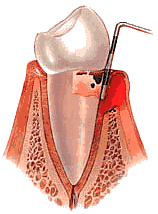
Gingivitis is the inflammation of gums, accompanied by redness, swelling, and a tendency to bleed. The most common cause is improper dental hygiene; however, other causes include poorly fitting dentures, poor occlusion, and it may occur in deficiency diseases, including blood dyscrasias, scurvy, or even metallic poisoning. Certain types of gingivitis, though uncommon, should be treated with a physician's care (i.e. gingivitis gravidum, or a type that results in extensive ulcerations: phagedenic gingivitis). Nevertheless, the most common type is easily treated through proper dental hygiene and is aided by herbal approaches discussed in the center column of this page.
Helpful Links

Gingivitis &
Periodontal Disease


Note: This information is provided for educational purposes only and is not intended to replace the use of a qualified health care professional. We strongly recommend the use of a physician for the diagnostic phase of any treatment. With an accurate diagnosis in hand, we believe the consumer, at that point, has a basic, unalienable right to seek out factual information on all therapeutic approaches, both orthodox and alternative, and choose those approach(es) that are right for them. Nonetheless, a "good doctor" should be considered a requisite starting point.